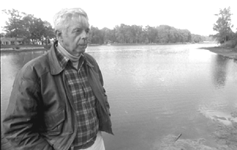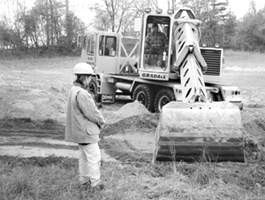
Dock of the Bay

Volume VII Number 17
April 29 - May 5,1999
Lost at Sea: First-Hand Stories of Risk & Rescue
"I couldn't stop it. From 25,000 feet, I was
going straight down at 250 miles an hour with nothing but water in front
me," recalls Joe Rooney, of Tracey's Landing, of the time rescuers
plucked him from the water.
Test pilot Rooney was flying an F4 Phantom jet in a training exercise 40 or 50 miles off Puerto Rico when his two-person plane failed.
He'd simulated ejection many a time, but this was the real thing. It was the kind of real-life dramatic rescue featured in the best-selling book The Perfect Storm and in a seminar that brought two of the front-line rescuers to Annapolis to talk about their experiences last week.
Rooney's story continues:
"The force is like getting hit in the rear end with a sledge hammer. The rockets shoot you 150 feet from the airplane. It takes 1.7 seconds, and in that instant in time you think, 'wow, I can't believe it, here I go.' And then kaboom!
"I shot out of the plane and was hit in the face with 250-mile-per-hour air. I stayed conscious but my eyes blacked out. Then me and the other guy were floating in water in our little rafts.
"You'd be surprised at how cold you can get in warm weather. In a raft three or four inches off the water, 10-foot swells seemed pretty high. You could only look around when you were on top of a wave, so the co-pilot and I were isolated from one another until we came up on top."
Rooney had had time for an emergency call, which alerted another jet to their position. It vectored in a CH46 Navy helicopter practicing landings on a nearby ship - "just a regular pilot who got a call-up to perform a search and rescue." Hovering overhead, the helicopter dropped down a line.
Then survival was up to Rooney. "You jump out of the raft, swim to the line and hook it on. They hoist you up. The wind is blowing 100 or 200 miles per hour under the prop wash, and you're swinging back and forth like a clock pendulum while they reel you in like a fish.
"It's a good team. When you're 40 or 50 miles out at sea, you know they're going to come get you. You're pretty happy to see them."
In the language of rescues, Rooney's was tame, not bringing much risk to him or his rescuers.
So two rescuers - Coast Guard Captain Jimmy Ng and Air National Guard Lieutenant Colonel Mike Canders - told a rapt audience at the U.S. Naval Institute's 125th Meeting and Ninth Annapolis Seminar.
Ng and Canders spoke in the Naval Institute panel, "The Value of One Life." Ng, who's been working rescues for 24 years, now balances life against life as risk assessor for the Coast Guard's Air station at Kodiak, Alaska, one of the world's most inhospitable places.
Canders, of the Suffolk County, New York Air National Guard Base, led the fruitless search for parajumper Rick Smith, the National Guardsman lost when his rescue helicopter fell out of "the howling gray sky [into] the ravaged ocean" in the October, 1991 storm that occasioned Sebastian Junger's book, The Perfect Storm.
Retired Navy Captain John Bonds, the former director of Navy sailing, moderated the panel. Speaking for blue water sailors and racers was Bernadette Brennan Bernon, editor of Cruising World.
To bring the reality of the sea's danger and rescue's risk home to his audience, Ng told a story:
About three weeks ago we received a brief Mayday from a fishing vessel in Shelikoff Straits, a huge, huge area.
The weather was pretty normal for Kodiak, blowing 30 or 40 knots, snowing, with the temperature right around freezing.
The boat had probably rolled over from icing in seas of 20 to 25 feet. That means we have four men in the water. They have a life raft, but most of the time when a boat rolls the raft does not release. I know they have survival suits, but did they get them? If they're in the water without survival suits, I know there's no hope and no need to take any risk.
But if they're in a life raft, they are probably alive.
We immediately launched a C130 helicopter, and it took off in about 30 minutes - we had to call a state road crew to clear a foot of snow off the runway - headed to sea in about a quarter-mile visibility, taking on ice on its rotors.
We'd already called in a second helicopter and the Coast Guard cutter Firebush, rousing people from homes. Driving in on four-wheel drive vehicles, it would take many of them a couple of hours to get to the station.
Forty miles out and icing, the first helicopter made the extremely difficult
decision to come home. It landed with about a half an inch of airframe ice
all over it. When the crew got into another 'copter, I told them not to
launch until weather cleared, and the forecast did not suggest any time
soon. I held them on the ground for four hours.
In the meantime, the EPIRB, a wonderful piece of equipment, had gone off, which is how I identified the boat and knew who the four men are. I've called their family and told them we were en route. Then I called again and told them we've come back and cannot launch
"Apart from actual combat, nothing is as dramatic as a rescue at sea in heavy weather," said retired Navy Capt. Jim Barber Jr., the Institute's chief executive officer, who opened the panel.
That's a truth well known by those who've been there or could be. As Rooney said afterward, "there are plenty of people in this community these guys have saved."
Tens of thousands more armchair readers know it in their bones since Junger published his "true story of men against the sea" in 1997.
Sailors have had an encyclopedia of lessons, reminded panelists, citing disaster upon disaster, including the recent "decimation of the sail racing fleet en route to Tasmania, with both multiple rescues and loss of life."
Rescuers risk their lives for "all sorts of vehicles - land, sea and air, from ships to planes to snowmobiles to balloons; and all sorts of operators - commercial, private, working and playing," Bonds noted.
Intended to provoke thought and stimulate preventive action, the panel considered just how far we should go at putting the rescuers at risk.
"Does everyone have a right to invoke this rescue effort, no matter how they got there or what their predicament is?" asked Bond.
It was clearly a good question, and one to which the mostly military audience rose, in suggestions ranging from prudence, self-sufficiency and foremindedness to using Emergency Position Indicating Radio Beacons or EPIRBs - which can now be rented for $30 a day from BoatUS. But the only simple answers came from the ones at greatest risk: the rescuers.
"If somebody needs help, we go without question," said the Air Guard's Canders. "For us it's a sacred trust that should not be compromised by any financial consideration."
-SOM
Backyard History: New Museum
Digs Up Local Past
Lyman Hall has opened a museum to highlight
finds from 18th-century Steward Shipyard.
Each summer, families travel to learn the history
and heritage of other lands and people. Before you leave Anne Arundel County,
take a look at history and heritage in your own backyard.
Remnants of Steward Shipyard, an 18th century shipping community, were rediscovered in the West River backyard of Lyman Hall and his wife June six years ago.
The Halls didn't know what was in their backyard until a state underwater archeologist, Bruce Thompson, approached them, wanting to walk the property for artifacts. In minutes, he found lumber nails, arrowheads and other aged items. An enthusiastic Hall, archeologists and volunteers have since set up excavation sites on the property to search for more treasures.
"We saw the shipyard come alive around us," Hall said.
To Hall's pleasure, Steward Shipyard has been chosen as a stop on the county's Celebrate 350 Passport to History. The nearly invisible shipyard is now an official historic site. So how to show people the work?
Open a museum. On Sundays from 1-4pm, you can wander a room in Galesville's Captain Clack Marine Building looking at discovered artifacts.
Take a look at an adz, a tool used for shaping timbers for ship framing, or see the slick, a chisel used to pare irregularities in timber.
Last summer, workers discovered the third cannonball on their digging
site. Time can be dated by the type of ammunition discovered. One of the
most fascinating artifacts, according to Hall, is the dogshore, used to
launch the vessels sideways from the shipyard. Pictures depict the wooden
apparatus in a chemical vat where it is being preserved.
When you visit the museum, you'll get more than meets the eye. Speak with Hall and the docent on duty. George Dattore, foundation treasurer, performs this duty on occasion. Together, they recreate the lives of the Stewards and offer tidbits of history correlating with that time period. They explain the significance of their project and of the discoveries to date.
"You never know what people have that has been handed down that is a little piece of information. Everything has a story," Dattore said.
Make sure you ask Dattore and the other members to share these stories with you as they have with local children.
"This is a very historic area and the heritage is very deep, and we'd like to pass this on to the children," Hall said. Some artifacts on display were donated by area residents. Whether walking down a local beach or searching through the dusty attic, many people have made significant finds.
Area classes have visited the excavation site. Chosen groups joined in searching for artifacts using magnetometers. These instruments, like metal detectors, penetrate the top layers of dirt to locate unseen objects.
To put the fun back in learning, schoolteacher Donna Ruhsam and some foundation members created an activity book for county fourth and fifth graders. In it, children can learn about the shipyard and color at the same time.
If you're looking for a way to enjoy the shipyard, become a shipyard volunteer. Many are needed to catalog artifacts at the Maryland Historical Trust Laboratory in Crownsville.
If you like to get your hands dirty, join in some digging at the excavation site. Or if you prefer to keep your hands clean, visit the museum and dig for the story.
-Mary Catherine Ball
Dig with Care, History's Everywhere
photo by Don KehneArcheologist
Heather Crowl watches for artifacts as Gradall operator Bill Hobbs scoops
earth.
 At the end of
a fallow field just off Route 4 in Prince Frederick, a handful of state,
county and contract archeologists keep watch as a Gradall crane extends
its massive arm over the suspected site of an 18th century tenant house.
Hydraulics droning, the Gradall's wide-bucketed paw reaches out.
At the end of
a fallow field just off Route 4 in Prince Frederick, a handful of state,
county and contract archeologists keep watch as a Gradall crane extends
its massive arm over the suspected site of an 18th century tenant house.
Hydraulics droning, the Gradall's wide-bucketed paw reaches out.
But the digger neither gouges nor scoops. Rather, the blade gently skims off a layer of dry grass and ivy, exposing a swath of topsoil just beneath. With a roar of the crane's engine, the bucket lifts away a tangle, emptying it atop a growing pile.
The diesel engine idles to a throb as archeologist Heather Crowl, wearing a hard hat, steps out and scans the exposed dirt. She signals to the crane operator with her thumb and index finger - like she's showing him a sugar cube - before she backs away.
Up in the cab, crane operator Bill Hobbs of Owings nods and guns the engine. With a surgeon's touch, Hobbs guides the bucket's blade gently across the ground to peel off a 12-foot long, inch-thin sliver of earth.
The dig continues, one thin slice at a time, until a living room-sized patch of topsoil has been stripped down to underlying clay.
What's happening in this isolated field in Prince Frederick is nothing new to Calvert County or most any other place in Southern Maryland. A growing population - and the construction that attends it - forever pushes the present against the past. No wonder: The region's fields and woods are rich with buried remains of Maryland's 350-year history, not to mention the other 10,000 years of prehistoric habitation before Europeans hit the shores.
To developers, those same fields and woods tell a different story: a story of progress, prosperity and, of course, profits. On this site, 126 townhomes and 100 units for elderly will rise.
Here, however, ground rules keep the meeting of present and past pleasant. Under a local zoning ordinance, developers around Prince Frederick must pay for archeological testing of a site before receiving a work permit. State and county guidelines meet federal regulations laid out in the National Historic Preservation Act of 1966.
"The county dictates what has to be done," explains Brett Guy, vice president of Osprey Group, the developers. Bids for archeological testing are awarded based on proposed cost, professional quality and timeliness.
Here the Bethesda engineering firm Dames & Moore is at work.
Not everyone with a shovel and a building plan has to call in archeologists. "Generally, archeology is required if federal funding or licensing is involved," says Janet Friedman, the archeology project manager at Dames & Moore. "If you're a private property owner using your own money, you can do want you want."
Prince Frederick is one of the few places in Maryland with its own ordinances requiring developers to perform archeological testing on proposed building sites. Annapolis is another.
Even if an archeological study is required by local ordinance or federal law, not every site gets dug. First, county and state archeologists review preliminary reports to determine whether the site contains cultural remains, and if so, whether what's there is important enough to dig up.
At this site, an earlier survey uncovered 18th century artifacts. Further tests in 1997 led archeologists to believe the site was part of Overton, a 250-acre plantation owned back then by Benjamin Hance.
Working under the clock, archeologists brought in the Gradall to strip off the 'plow zone' or topmost layer that has been disturbed by farming over the years. Two storage pits and a few post holes are found.
At the end of the day, everyone seems satisfied. But the relationship between developer, for whom time is money, and archeologist remains an uneasy one.
"I have mixed feelings," Osprey Group's Brett Guy says. "It's a big burden to have a site found on your property, then to come up with the cash to do the archeology." For this project, that's about $30,000.
-Don Kehne
BEE There: Groan-Ups Spell for Literacy's Sake
Don't take time to ruminate over this sublime opportunity!
Philologists and sesquipedalians as well as lots of ordinary folks are invited to join the fun at the 1999 BEE for Literacy.
The Calvert County Literacy Council's lively evening of competitive spelling for adults pits teams in competition for the title of adult spelling champions. Unlike the (much) more formal Scripps-Howard National Spelling Bee competition for middle schoolers, competitors in this BEE wear costumes and are discouraged from taking themselves too seriously. Rowdy fans cheer their teams on.
"It was so tremendously nerve racking," remembers Kathie Eichfeld, captain of last year's Calvert County Library team. "We were sure we were going to miss a simple word. I told my team, please, let's not miss on the first round."
The Calvert Marine Museum will defend their 1998 BEE champion title against the likes of dentists, including North Beach Mayor Mark Frazer and his brother, lawyers, journalists - including a New Bay Times team - bankers, librarians and more. A few slots remain for brave souls willing to join the team competition. Team sponsorship fee is $250.
If you'd rather cheer than spell, come look on as your friends and neighbors demonstrate sangfroid as they strive for the copacetic spelling to survive this affable foofaraw. Watch the polyglot challenge neophyte for the championship niche.
From the mendicant to the bombast, the BEE for Literacy promises an evening of lively and ludicrous entertainment to support the Calvert County Literacy Council's work in our community. Sophists and carpers, however, need not apply to join in this evening of benign superciliousness.
Last year $10,000 was raised by the Calvert County Literacy Council to train tutors, buy reading materials and promote family literacy. Corporate sponsor for the event is Calvert Bank. Other major sponsors include Bay Mills Development Corporation and Recorded Books.
The BEE gets buzzing Friday, May 7, at the Stallings-Williams American Legion Post in Chesapeake Beach. Tickets to this dinner and lively team spelling competition for adults are on sale through May 3 at all branches of Calvert Bank and the Calvert Library.
A cash bar opens at 5:30pm followed by dinner at 6:30 and spelling at 7:30. Audience tickets are $20: 410/535-3233.
-Kathleen O'Brien Branch
In Virginia, conservationists and officials last week dedicated the Boshers Dam Fishway, a concrete ladder of baffles that will allow fish to travel hundreds of miles back to their traditional spawning grounds on the James River ...
In the Netherlands, environmental minister Jan Pronk has a suggestion that is sure to send some folks into their yards looking for black helicopters. In last week's Earth Times, Pronk proposed creating an international "Green Interpol" to handle the investigation, policing and prosecution of environmental criminals ...
In the Ukraine, the number 13 was unlucky last week for people living in the shadow of the Chernobyl nuclear station. It was the 13th anniversary of the plant explosion, and since then 4,000 people have died from diseases connected to the disaster ...
Our Creature Feature comes to us from Washington State, where, if you're fishing some day, you might be startled by what you find at the end of your hook.
The fish may look like a salmon, but it's not what you think. If you clean it you'll find wires and sensors, not guts. And if you eat it well, if it tastes like rubber, that's because it is.
It's Flubber, a salmon replica being engineered by Alden Research Laboratory. No, it's not a toy. The fake fish will be used to measure how salmon are jostled, scraped and killed on their journey through a hydropower dam.
| Issue 17 |
Volume VII Number 17
April 29 - May 5, 1999
New Bay Times
| Homepage |
| Back to Archives |